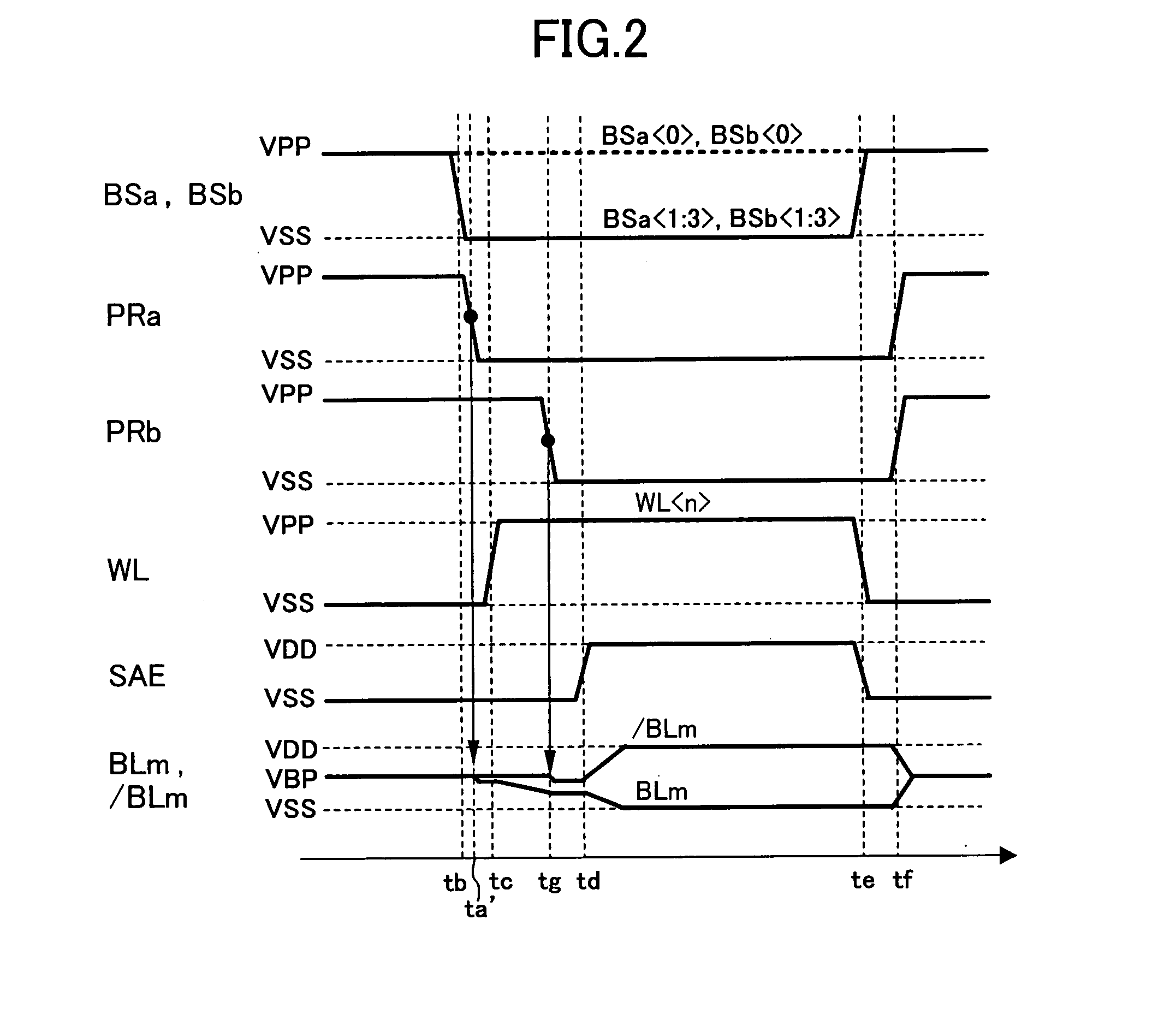Semiconductor memory device
a memory device and semiconductor technology, applied in the field of semiconductor memory devices, can solve the problems of reducing the size of the column of sense amplifiers, affecting the performance, and the influence of noise is more serious, so as to improve the charge transferring speed of the hierarchical switch, suppress the noise of bit lines, and increase the operation margin of the semiconductor memory device.
- Summary
- Abstract
- Description
- Claims
- Application Information
AI Technical Summary
Benefits of technology
Problems solved by technology
Method used
Image
Examples
modification 1
[0117]FIG. 3 is a circuit diagram for showing the configuration of a semiconductor memory device according to Modification 1. In the semiconductor memory device of FIG. 3, precharge transistors 40a, 40b, 41a, 41b, 42a, 42b, 43a, 43b, etc. working as local bit line precharge circuits are further provided in the semiconductor memory device of FIG. 1.
[0118]The precharge transistor 40a is connected between the precharge power source and the local bit line BLl0, and the precharge transistor 40b is connected between the precharge power source and the local bit line / BLl0.
[0119]The precharge transistor 40a supplies the bit line precharge voltage VBP to the local bit line BLl0 in accordance with a signal on a precharge control signal line PRa0>, and the precharge transistor 40b supplies the bit line precharge voltage VBP to the local bit line / BLl0 in accordance with a signal on a precharge control signal line PRb0>.
[0120]Similarly, the precharge transistor 41a is connected between the prec...
modification 2
[0125]FIG. 5 is a timing chart for showing a read operation of a semiconductor memory device according to Modification 2.
[0126]In the read operation of FIG. 5, in the semiconductor memory device of FIG. 3, a signal the same as that on the precharge control signal line PRa is supplied to the precharge control signal line PRa0> for controlling the precharge transistor 40a for precharging the local bit line BLl0 connected to the memory cell to be accessed, and a signal the same as that on the precharge control signal line PRb is supplied to the precharge control signal line PRb0> for controlling the precharge transistor 40b for precharging the local bit line / BLl0 paired with the local bit line BLl0.
[0127]On the other hand, the precharge control signal lines PRa1:3> and PRb1:3>for controlling the precharge transistors 41a through 43a and 41b through 43b for precharging the local bit lines BLl1 through BLl3 and / BLl1 through / BLl3 other than the local bit lines related to the memory acc...
modification 3
[0129]FIG. 6 is a circuit diagram for showing the configuration of a semiconductor memory device according to Modification 3. The semiconductor memory device of FIG. 6 is obtained by further adding equalizing transistors 50, 51, 52, 53, etc. working as an equalizing circuit to the semiconductor memory device of FIG. 1.
[0130]The equalizing transistor 50 connects the local bit lines BLl0 and / BLl0 to each other in accordance with a signal on an equalizing control signal line EQ0>. Similarly, the equalizing transistor 51 connects the local bit lines BLl1 and / BLl1 to each other in accordance with a signal on an equalizing control signal line EQ1>, the equalizing transistor 52 connects the local bit lines BLl2 and / BLl2 to each other in accordance with a signal on an equalizing control signal line EQ2>, and the equalizing transistor 53 connects the local bit lines BLl3 and / BLl3 to each other in accordance with a signal on an equalizing control signal line EQ3>.
[0131]FIG. 7 is a timing ...
PUM
 Login to View More
Login to View More Abstract
Description
Claims
Application Information
 Login to View More
Login to View More - R&D
- Intellectual Property
- Life Sciences
- Materials
- Tech Scout
- Unparalleled Data Quality
- Higher Quality Content
- 60% Fewer Hallucinations
Browse by: Latest US Patents, China's latest patents, Technical Efficacy Thesaurus, Application Domain, Technology Topic, Popular Technical Reports.
© 2025 PatSnap. All rights reserved.Legal|Privacy policy|Modern Slavery Act Transparency Statement|Sitemap|About US| Contact US: help@patsnap.com



